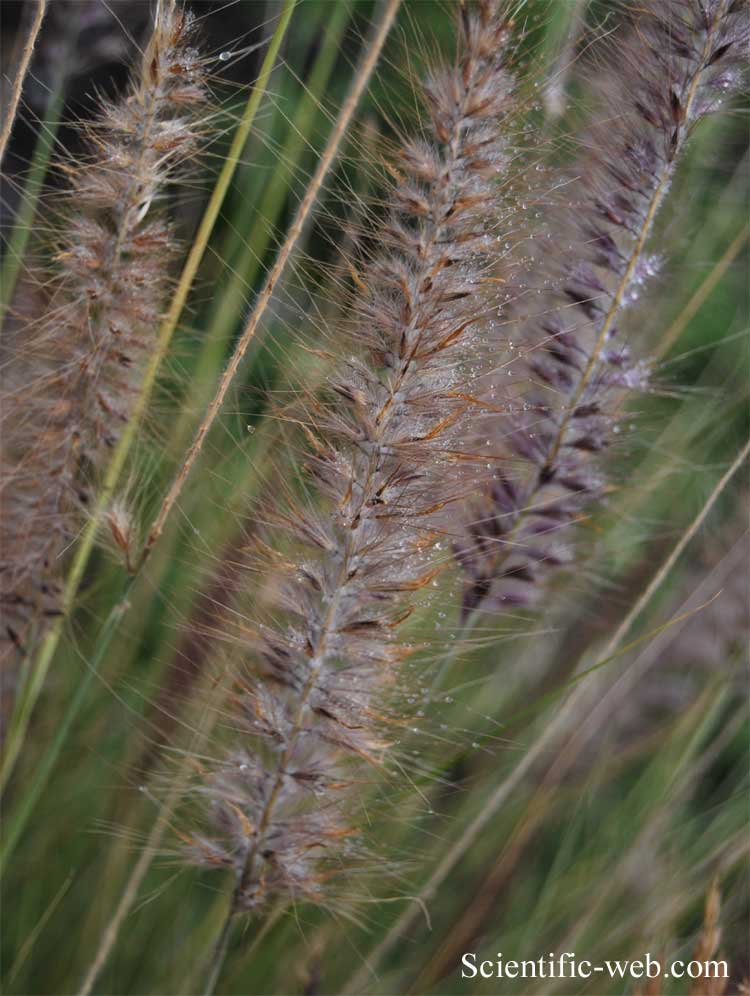
Cenchrus setaceus, Photo: Michael Lahanas
Classification System: APG IV
Superregnum: Eukaryota
Regnum: Plantae
Cladus: Angiosperms
Cladus: Monocots
Cladus: Commelinids
Ordo: Poales
Familia: Poaceae
Subfamilia: Panicoideae
Tribus: Paniceae
Subtribus: Cenchrinae
Genus: Cenchrus
Species: Cenchrus setaceus
Name
Cenchrus setaceus (Forssk.) Morrone, Ann. Bot. (Oxford) n.s., 106(1): 129. (2010)
Synonyms
Basionym
Phalaris setacea Forssk., Fl. Aegypt.-Arab. 17 (1775).
Type locality: "In desertis Kahirinis. Raetam." Mukhajah, J. Barad ("Mokhaja, Mt. Barak" on field label) [Yemen]
Holotype: Forsskål #117; 1763-03; C C10002753.
Homotypic
Pennisetum setaceum (Forssk.) Chiov., Bull. Soc. Bot. Ital. 1923: 113 (1923)
Heterotypic
Pennisetum erythraeum Chiov., Annuario Reale Ist. Bot. Roma 8: 39 (1903)
Pennisetum numidicum Paris, nom. nud., Bull. Soc. Bot. France 18: 263 (1871)
Pennisetum orientale var. altissimum Chiov., Annuario Reale Ist. Bot. Roma 7: 66 (1897)
Pennisetum orientale subsp. parisii Trab., Bull. Soc. Bot. France 24: 391 (1887)
Pennisetum orientale var. parisii (Trab.) Leeke, Z. Naturwiss. 79: 26 (1907)
Pennisetum parisii (Trab.) Trab., Fl. Algérie, Monocot.: 136 (1895)
Pennisetum phalaroides Schult., nom. superfl., Mant. 2: 147 (1824)
Pennisetum rueppelianum hort., nom. superfl., Atti Congr. Bot. Genova: 366 (1893)
Pennisetum ruppellii Steud., Nomencl. Bot., ed. 2, 2: 298 (1841)
Pennisetum ruppellii var. depauperatum Schweinf., Bull. Herb. Boissier 2: 96 (1894)
Pennisetum scoparium Chiov., Annuario Reale Ist. Bot. Roma 8: 38 (1903)
Pennisetum spectabile Fig. & De Not., Mem. Reale Accad. Sci. Torino, ser. 2, 12: 248 (1852)
Pennisetum tiberiadis Boiss., Diagn. Pl. Orient. 13: 43 (1854)
References
Primary references
Chemisquy, M.A., Giussani, L.M., Scataglini, M.A., Kellogg, E.A. & Morrone, O. 2010. Phylogenetic studies favour the unification of Pennisetum, Cenchrus and Odontelytrum (Poaceae): a combined nuclear, plastid and morphological analysis, and nomenclatural combinations in Cenchrus. Annals of Botany, 106(1): 107–130. DOI: 10.1093/aob/mcq090 Full text PDF Reference page.
Forsskål, P. (†). 1775. Flora Aegyptiaco-Arabica. Sive descriptiones plantarum, quas per Aegyptum inferiorem et Arabiam felicem detexit, illustravit Petrus Forskål. Post mortem auctoris edidit Carsten Niebuhr. Ex officina Mölleri, Hauniae [Copenhagen]. DOI: 10.5962/bhl.title.41 BHL Reference page. : 17
Links
Hassler, M. 2019. Cenchrus setaceus. World Plants: Synonymic Checklists of the Vascular Plants of the World In: Roskovh, Y., Abucay, L., Orrell, T., Nicolson, D., Bailly, N., Kirk, P., Bourgoin, T., DeWalt, R.E., Decock, W., De Wever, A., Nieukerken, E. van, Zarucchi, J. & Penev, L., eds. 2019. Species 2000 & ITIS Catalogue of Life. Published on the internet. Accessed: 2019 Oct. 25. Reference page.
International Plant Names Index. 2019. Cenchrus setaceus. Published online. Accessed: Oct. 25 2019.
Govaerts, R. et al. 2019. Cenchrus setaceus in Kew Science Plants of the World online. The Board of Trustees of the Royal Botanic Gardens, Kew. Published on the internet. Accessed: 2019 Oct. 25. Reference page.
Tropicos.org 2019. Cenchrus setaceus. Missouri Botanical Garden. Published on the internet. Accessed: 2019 Oct. 25.
Vernacular names
العربية: ثيوم شائك
Deutsch: Afrikanisches Lampenputzergras
English: Fountain grass
italiano: Penniseto allungato
svenska: Fjäderborstgräs
Cenchrus setaceus, commonly known as crimson fountaingrass, is a C4 perennial bunch grass that is native to open, scrubby habitats in East Africa, tropical Africa, the Middle East and south-western Asia. It has been introduced to many parts of the world as an ornamental plant, and has become an invasive species in some of them. It is drought-tolerant, grows fast, reaches 3 feet in height, and has many purple, plumose flower spikes.
Environmental threat
Fountaingrass has been introduced to the Canary Islands,[1] Sicily, Sardinia, southern Spain, Australia,[2] South Africa, Hawaii, the western United States,[3] southern Florida and New Caledonia.[4] It thrives in warmer, drier areas and threatens many native species, with which it competes very effectively as an invasive species. It also tends to increase the risk of intense wildfires, to which it is well adapted, thus posing a further threat to certain native species.[5]
In Europe, Fountain grass is included since 2017 in the list of Invasive Alien Species of Union concern (the Union list).[6] This implies that this species cannot be imported, cultivated, transported, commercialized, planted, or intentionally released into the environment in the whole of the European Union.[7]
References
"Tackling Exotic Flora in the Teno Rural Park". Secret Tenerife. 28 January 2007. Retrieved 2009-02-26.
"Fountain Grass". Weed Identification & Information. Australian Weeds Committee. Archived from the original on 2008-08-04. Retrieved 2009-02-26.
"Fountain Grass". Alien Plant Working Group. Plant Conservation Alliance. Retrieved 2009-02-26.
Hequet, Vanessa (2009). Les espèces exotiques envahissantes de Nouvelle-Calédonie (PDF) (in French). p. 17.
"Eradicating invasive alien species: the battle against African fountain grass". Times of Malta. 30 October 2021.
"List of Invasive Alien Species of Union concern - Environment - European Commission". ec.europa.eu. Retrieved 2021-07-27.
"REGULATION (EU) No 1143/2014 of the European parliament and of the council of 22 October 2014 on the prevention and management of the introduction and spread of invasive alien species". Archived from the original on 2017-03-03.
Retrieved from "http://en.wikipedia.org/"
All text is available under the terms of the GNU Free Documentation License

